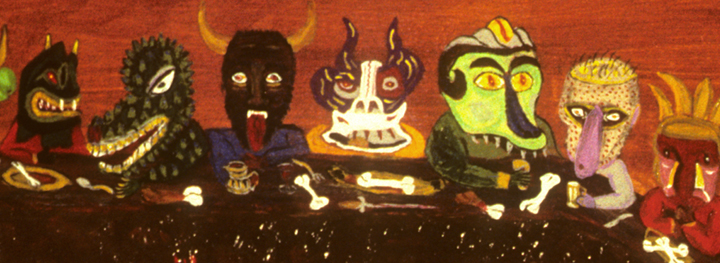Art & Art History
James Lamb

Gallery 400
400 South Peoria Street, Chicago, IL 60607
This exhibition comprises a series of twenty-four paintings, two diagrams, and twenty-four storyboards created by James Lamb from 1986–89. The artist began painting late in life, during retirement. Without any formal artistic training, he began to paint as a means of expressing his personal experiences and observations. His paintings often take the form of satirical commentary on contemporary society, including the people and situations around him. From a relatively small Midwestern town, Lamb both amused and irritated friends and neighbors with his caustic wit; many of those around him ignored his images and moralizing, preferring to write him off as an eccentric. Lamb, obsessed with the need to paint these commentaries, has not endeared himself to his fellow citizens. He does not have, to his neighbors ’ way of thinking, the credentials to be an artist. Locals know that he has emerged from the same past as they have, a way of life founded on reserved, indirect traditions of privacy. It is the public candor of his paintings that violates this reserve. Didacticism is a strong motivating force in his work. The works are intended, according to Lamb, to teach or lecture the viewer. An unwavering sense of his mission, and an ability to ignore conventions, has encouraged him to realize his visions.
Lamb’s work operates on many different levels, trying to glean some essential meaning, emotion, or even intent, out of the world around him. Viewing his art is a bit like slowly chipping away at an oyster in order to find the pearl. His work is a taunting combination of the ideal and its antithesis. His characters are so strong that the viewer is drawn into the scene only to find the distortions and enigmatic personalities all too often recognizable.
Viewing his art is a bit like slowly chipping away at an oyster in order to find the pearl.
It is tempting to perceive the personal and private quality of these paintings as confessional manifestations of Lamb’s own obsessions. They are in fact far more complex and contradictory. As mock fictions, these carefully constructed scenarios insinuate and moralize generic stereotypes. Essentially narrative in content, Lamb’s work depicts the world of the innocent and naive, but also the corrupt and jaded. Through his paintings, viewers realize that it is progressively harder to ignore our own complicated transgressions and trepidations of life. Lamb conveys a conflict between the tragic-comic perspectives in his farces. He confronts subject matter by exploring the fear, narcissism, optimism, determination, and vulnerability that we all have but often refuse to see.
To respond to his paintings and to put them on a plane with advanced and highly evolved works of art is not a denial of their elementary artistic level. They cannot be treated as a model for the professional artist to imitate, but in their naïveté they are the bearers of a precious, fresh perception. Lamb’s work is more about the artistic impulse, the creative communicative impulse. This premier exhibition unveils one artist’s work, bringing to light an artistic and social phenomenon of significance. Like other forms of modern art, his paintings often give unique insight into our contemporary world.
James Lamb (born 1926) is an artist, entrepreneur, and thinker from Beloit, Wisconsin. He came to painting late in life, during retirement. Though he has no professional training, Lamb offers a fresh perspective; his works often take the form of satirical commentary on contemporary society, including the people and situations around him.